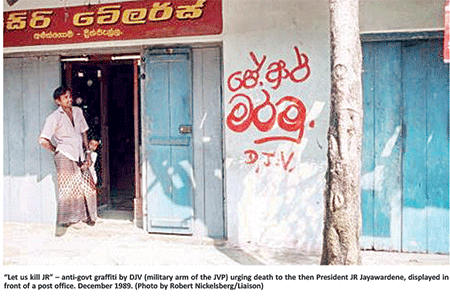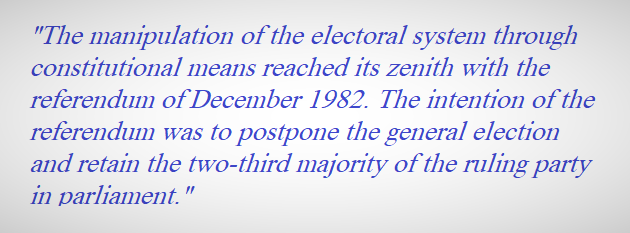Paradox of Democracy and Attrition of Civic Space in Sri Lanka: Quo Vadis?
The erosion of hegemony of the ruling historic bloc, and the crisis of the state and democratic institutional decay reached a new phase after 1977. After gaining a landslide victory with a five-sixths majority at the 1977 elections, the UNP government under J.R. Jayewardene initiated a new policy regime identified as the ‘Open Economic Package’. Corollary to the policy of trade liberalization and deregulation of the economy after 1977, the state withdrew from its direct role in day-to-day economic life, marking a clear departure from the earlier policy. The market mechanism was given greater autonomy and the market forces were considered the engine of growth.
In the political domain, the UNP regime under J.R. Jayewardene took systematic steps to instill many authoritarian features to the political system that was sanctified by the new constitution of 1978. The all-powerful Executive Presidency was introduced as the centre of gravity in the political order and placed it above the law by making it immune to court proceedings. After the introduction of the proportional representation along with Executive Presidency, the authority of the party leadership was firmly stamped. The undated resignation letters obtained from the members of Parliament and the practice of appointing ‘Chit MPs’ destroyed the legitimacy of the legislative branch of the government. The five-sixths majority in parliament was often used to amend and manipulate the very constitution, making constitutionalism a farce. The 1978 constitution was amended 16 times in 10 years, contributing towards democratic deficit.
Another aspect of the subversion of democracy by the regime in power was its disregard for the rule of law and independence of the judiciary. When a police officer was found guilty and fined by the Supreme Court for violation of fundamental rights by seizing leaflets at a political meeting in 1982, the government decided to reimburse the fine out of public funds and immediately give a promotion to the officer involved. It was not an isolated incident. On another occasion, a senior Leftist politician (Ms. Vivienne Gunawardena) complained of assault and unlawful arrest. The Supreme Court held that her arrest was unlawful and unconstitutional and ordered the state to pay her compensation. On the day the decision was delivered, the very police officer was promoted. A few days later, a gang of thugs linked to a government minister paraded outside the houses of the three judges who delivered the judgment and shouted obscenities at them.
The UNP regime under President J.R. Jayewardene carried out an overt strategy to weaken the parliamentary opposition. The use of coercion against political opposition was systematic and ruthless. The deprivation of civic rights of Mrs. Sirimavo Bandaranaike, the leader of the main opposition party, came in this context. The faux Naxalite conspiracy of 1982 was used to imprison main campaigners of the SLFP to win the infamous referendum. In order to attain short-term political stability, the regime ignored, if not undermined, basic fundamentals of parliamentary democracy. As a result, the entire system lost its credibility.
The manipulation of the electoral system through constitutional means reached its zenith with the referendum of December 1982. The intention of the referendum was to postpone the general election and retain the two-third majority of the ruling party in parliament. The manner in which the referendum was conducted was a clear deviation from a relatively free-elections that Sri Lankan electorate had been accustomed to. At the referendum the ruling party resorted to mass scale rigging and open violation of election laws, making the entire Sri Lankan democracy a farce. President Jayewardene seemed to have believed that by the referendum he received a Carte Blanche, a blatant antithesis of democracy. In his address to the annual convention of the ruling party after winning the referendum, the President stated that the country needs one strong individual who feared neither the judiciary, the legislature, nor the party and that he had the power to do anything for the next six more years .
The measures to achieve political stability taken after 1977 at the expense of democratic political structures and processes however backfired. The ethnic conflict began to take a new turn after the ethnic riots in July 1983. A new wave of military confrontation began in January 1984. The failure of political initiatives to find a political solution to the ethnic problem on the part of both the state and the Tamil militants aggravated the armed conflict leading to the direct Indian military intervention in 1987. The resulted Indo-Sri Lankan Accord which gave birth to the 13th Amendment to the Constitution providing a Provincial Councils system, which, from the very outset, carried a certificate of illegitimate birth due to Indian intervention.
Using the 1983 riots as a pretext, the JVP was proscribed and pushed to go underground. The contraction of the civic space and breakdown of democratic structures reached its zenith during the second JVP uprising in 1987-89. The scale and intensity of violence was unprecedented and the situation of the country deteriorated virtually to the Hobbesian ‘state of nature’. The regime was able to put down the second JVP insurgency finally by employing a high dose of extra-judicial force. The end of southern insurrection did not bring political stability to the country. The renewed armed conflict in the North and East became the main feature in the conflict architecture of the country.
After the suppression of the second JVP uprising, President R. Premadasa appointed the ‘Presidential Commission on Youth’ on 19 October 1989, with the mandate to examine the causes of youth unrest and to recommend remedial measures. The Commission Report vividly revealed how the politicization of recruitment to the public service was a main source of resentment on the part of the youth. It noted that the practice of enjoying all the benefits and rewards by political class has caused a spiraling sense of frustration. The Youth Commission Report put forward a number of constructive recommendations in the direction of democratization of the state. The commission recommended a reversal of the over-politicization of society, a control of the misuse and abuse of political power and a prevention of arbitrary political interferences in public institutions. It also recommended that a quota system should be provided for youth to increase youth representation in local level institutions. Most important step taken by the Premadasa administration soon after the Youth Uprising was the allocation of a quota of 40 percent to youth candidates between age of 18-35 in local government authorities by proposing an amendment to the Local Authorities Elections (Amendment) Act no. 25 of 1990. However, after the initial urgency worn off, the interests in implementing other recommendations of the Youth Commission fizzled out.
Yielding to the demand on the part of democratic forces, including the Left parties for more inclusive democracy, another important step taken by the Premadasa administration was the reduction of the district votes cut off point from 12.5 percent to 5 percent through the 15th Amendment to the Constitution.
Paradoxically, President Premadasa concentrated the executive powers as much as possible in his hands, making the entire administration akin to a ‘one-man show’. The role played by the infamous ‘Lawrence Unit’ which reported directly to the President sent shock waves to all the political and administrative personalities below the President. The modes operandi of President Premadasa has brought many obnoxious features of the Executive Presidency into focus of the wider sections of society. By the time of the tragic death of President Premadasa, a cry for a democratic change of the political system was gaining momentum.
The Peoples’ Alliance regime that came to power in 1995 with a huge mandate to abolish the Executive presidency attempted to make political reforms a priority in its political agenda. The new regime linked all its political reform proposals with a proposed political solution to the ethnic problem in one single package, and did not want to pursue a piecemeal approach to Southern political reforms. Furthermore, the PA regime imprudently counted on the goodwill of the main parliamentary opposition in implementing its political reform package, instead of going to the people directly bypassing the opposition political leaders. By dragging on the discussions with the opposition, the PA allowed the historic opportunity to lapse and squandered the congenial political climate for structural political reforms, which prevailed after the elections in 1995. When the Elam War took a new turn in 1999, the reform agenda of the PA regime lost its credibility in the context of a series of military setbacks to the Government forces. The blatant violation of election laws and the use of coercion during infamous Wayamba Provincial Council Elections in 1999 caused irreversible damage to democratic credentials of the People’s Alliance Government.
To be continued.
By Gamini Keerawella, Professor Emeritus, University of Peradeniya. (The Island)



 i
i